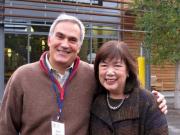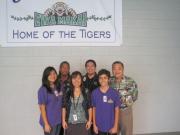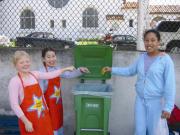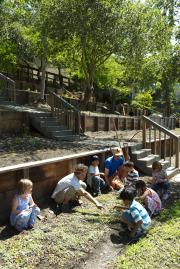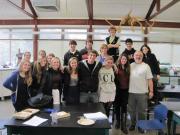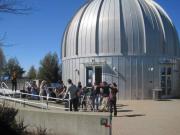Greening America’s Schools 2.0: Spring 2012
In my continuing journey to document success stories for Greening America’s Schools 2.0, here are four schools that represent the may varieties of schools seeking to become more sustainable: Overlake School, WA; Savannah Country Day School, CA; Montessori de Terra Linda, CA; and New Highland Academy, CA.
Overlake: A Green Ribbon School
In April 2012 The Overlake School, an independent school with 530 students in grades 5-12 in Redmond, Washington near Seattle, was named one of the country’s first Green Ribbon Schools by the U.S. Department of Education, just one of 78 nationwide and one of eleven NAIS member schools. How does one become recognized as a high-performance, environmentally sustainable school? 
Years ago I met the school’s long-time head, Frank Grijalva, when he joined the faculty with me at SF University HS to start our jazz music program. Frank’s talents were quickly apparent at University, especially his ability to develop ensembles of young musicians. In his later work as a school head in San Francisco, Italy, and The Overlake School, where he served from 1995, he used that ability to motivate teams to promote school improvement. Moved by the beautiful environment in the Pacific Northwest and “an obligation to preserve,” he encouraged the staff and students at Overlake to “begin with small steps like recycling and composting” and then launched a larger effort in 2007.
Sustainability Director Melody Gulledge played a role in that effort, initially volunteering to coordinate the parent-supported OWLS (Outdoor-Wise Learning Spaces) project that created 2.5 miles of trails and interpretive signs on the school’s 75-acre campus. Raised east of Seattle on a farm, she remembers developing a love of nature walking in the nearby woods and on “leave no trace” camping trips with her father. Trained as an engineer, she designed planes for Boeing before her two boys enrolled at Overlake and she became engaged as a parent volunteer. In 2011 she succeeded the first Sustainability Director and led the Green Ribbon process.
Overlake’s Green Ribbon Schools application captures well the school’s significant, systemic sustainability accomplishments in the three “pillars” identified by the Department of Education: efficient facilities, healthy operations, and an environmental curriculum. Beginning with a campus-wide energy audit, Overlake implemented facilities upgrades with “water restrictors, energy efficient lighting, and occupancy sensors that drove immediate results.” A series of campus construction projects included “smart, efficient, and remotely accessible, digitally-controlled HVAC systems” and included a new solar array. One building is LEED-certified, with a green rooftop, cisterns, low flow toilets, insulation made of blue jeans, and wood recycled from the building that was torn down; two other buildings follow LEED strategies and specifically meet Washington Sustainable Schools Protocol (WSSP). 
With a concern for the “triple bottom line” and a commitment to measurement, they noted in their Spring 2012 Eco-Report Card that “utility expenses are lower by $60,000 over four years” with “190 tons of carbon dioxide that have been prevented – similar to taking 33 cars off the road for a full year.” They also report that “landfill waste has been diverted by 42% by recycling and composting, and carpooling is being taken advantage of by 61% of students and 22% of faculty either walk, bike, or vanpool to work.”
Overlake has focused on healthy conditions throughout the campus. They use digitally controlled ventilation systems to circulate fresh air and “economizers” to bring in cool air at night, eliminating the need for cooling during warm days. Buildings are designed for naturally- lighted indoor spaces and the outdoor environment features wetlands and ponds, rain gardens, cisterns and a green roof.
The cafeteria staff has revised the menu to offer local, sustainable, organic food as part of their own “farm-to-school” program.
Environmental awareness and education is integrated into the academic and extra-curricular program. The Outdoor Education Program curriculum ensures that students understand the meaning of “leave no trace,” there is an Outdoor Education graduation requirement, and a third of the annual Project Week classes are conducted outdoors or involve environmental protection and sustainability. 
This brief account can only sketch the outline of the story about how The Overlake School moved from its first, formal environmental sustainability commitment in 2007 to being recognized as a national leader five years later. The school’s Going Green Blog, however, describes the vision and historical process that led to that transformation. Schools seeking to follow Overlake’s leadership will find this a valuable resource for innovation.
Savannah Country Day School: Inspiring Students to Stewardship
Long engaged in environmental education, Savannah Country Day School has recently received national recognition for its exceptional efforts in becoming a model green school.  With its mission to prepare students to “meet with confidence, imagination, and integrity the challenges of college and of life,” the school has engaged and empowered its students to follow an Eco-Code and become environmental stewards. That tradition has deep roots.
With its mission to prepare students to “meet with confidence, imagination, and integrity the challenges of college and of life,” the school has engaged and empowered its students to follow an Eco-Code and become environmental stewards. That tradition has deep roots.
Originally established in the early twentieth century, the modern Savannah Country Day School was founded in 1955 on a large, wooded piece of property about ten miles from the Atlantic and the barrier islands. In the 1970s the Lower School head incorporated a garden into the program to teach “lessons learned from growing things,” and that first vegetable garden eventually blossomed to include gardens in every division for butterflies, herbs, fruit and several with their own names: Brown Thumb Garden, Monet Garden, Organic Spot, Shakespeare Garden, and Pangaea Garden.  Now in conjunction with the schools SAGE food service, they offer produce from these gardens as well as food sourced from local farms. From the gardens they manage, students also donate “hundreds of pounds of vegetables from the garden to a local food bank.”
Now in conjunction with the schools SAGE food service, they offer produce from these gardens as well as food sourced from local farms. From the gardens they manage, students also donate “hundreds of pounds of vegetables from the garden to a local food bank.”
Around 2007 the school began to make environmental sustainability a major focus for its facilities, operations and curriculum. That year Carrie Stubbs-Vitrovsky joined the faculty as a second grade teacher and brought a strong environmental perspective to the school, one which enabled her and several other teachers to present Savannah Country Day’s application as a Green Ribbon School.  She herself grew up on her grandparents’ farm in southwestern Ohio and has fond memories of riding horses, playing outdoors, and learning about the geothermal energy system they installed. Carrie credits her mother, who teaches rhetoric with a focus on environmental issues at Kent State, and a professor at Ohio University, for inspiring her to begin teaching outdoor education and then to become a classroom instructor.
She herself grew up on her grandparents’ farm in southwestern Ohio and has fond memories of riding horses, playing outdoors, and learning about the geothermal energy system they installed. Carrie credits her mother, who teaches rhetoric with a focus on environmental issues at Kent State, and a professor at Ohio University, for inspiring her to begin teaching outdoor education and then to become a classroom instructor.
With student initiatives Savannah Country Day deepened its conservation ethic when a group of fourth graders launched the “Give a Flip: It’s the Bright Idea” campaign to turn off lights that led to considerable financial savings. Student campaigns encouraged recycling of aluminum, paper and now green waste for composting. 

Savannah Country Day School has been justly recognized for its systematic effort to become a green school. In 2006 was certified by the National Wildlife Federation as a Schoolyard Habitat; as their application stated: “Our schoolyard habitats are crucial in the areas of science, art, language arts, media, and computer science in helping us achieve our cross curricular goals, standards and benchmarks.  The students benefit from the integrated lessons and team teaching such cross-curricular learning provides.” In 2011, the school became the nation’s first National Wildlife Federation Green Flag recipient. And in April 2012 Savannah Country Day School became one of just 78 schools, and just 12 private schools to be selected as a Green Ribbon School. As the school declared in its application, “by empower our students to care for and about the earth, and by enabling them to learn the lessons provided by time spent outdoors,” Savannah Country Day School is raising a new generation of environmental stewards.
The students benefit from the integrated lessons and team teaching such cross-curricular learning provides.” In 2011, the school became the nation’s first National Wildlife Federation Green Flag recipient. And in April 2012 Savannah Country Day School became one of just 78 schools, and just 12 private schools to be selected as a Green Ribbon School. As the school declared in its application, “by empower our students to care for and about the earth, and by enabling them to learn the lessons provided by time spent outdoors,” Savannah Country Day School is raising a new generation of environmental stewards.
Montessori de Terra Linda: A Model for Green School Reform
When the Italian physician and educational reformer Maria Montessori developed her educational philosophy just a century ago, she could little imagine that it would grow to become a global movement with 20,000 schools and significant influence on educational reform today.  Recently, when speaking about greening schools at the California Independent School Business Managers Association, I met Karen Walls, Business Manager at Montessori de Terra Linda, a pre-K through sixth grade school with 140 students in Marin County. And in my subsequent visit to her school, I discovered the natural affinity between Montessori and environmental education.
Recently, when speaking about greening schools at the California Independent School Business Managers Association, I met Karen Walls, Business Manager at Montessori de Terra Linda, a pre-K through sixth grade school with 140 students in Marin County. And in my subsequent visit to her school, I discovered the natural affinity between Montessori and environmental education.
Montessori education has been much in the news lately.  An article in the Wall Street Journal posted on the school’s website noted that some of the most creative American minds were Montessori educated, people like Google founders, Larry Page and Sergei Brin, Amazon’s head Jeff Bezos, and French chef Julia Child. Montessori’s core principles read like recent descriptions of 21st century education--that people learn best when interested and given a chance to discover, solve real-world problems, and construct meaning; that collaboration can be very conducive to learning; and that place-based learning can be memorable.
An article in the Wall Street Journal posted on the school’s website noted that some of the most creative American minds were Montessori educated, people like Google founders, Larry Page and Sergei Brin, Amazon’s head Jeff Bezos, and French chef Julia Child. Montessori’s core principles read like recent descriptions of 21st century education--that people learn best when interested and given a chance to discover, solve real-world problems, and construct meaning; that collaboration can be very conducive to learning; and that place-based learning can be memorable.
In their core values, Montessori de Terra Linda states that “we share a respect for self, others, our world and our environment.” In conversation with the school’s leadership, I learned how MdTL translated that vision to “create an environment of health and sustainability throughout the MdTL campus and community.”  School Head Mary Yahnke grew up near Chicago and recalls muddy walks in the woods with her mother that sparked her love of nature. Karen Walls herself was raised Hyde Park near Lake Michigan and was fascinated by the lagoon at the Museum of Science and Industry created by architect Daniel Burham. And parent volunteer Cleary Vaughan-Lee, raised on a Virginia farm, says that having children at MdTL “caused me to rethink my relationship to the world.” With her filmmaker husband, she has been inspired to launch the GlobalOnenessProject and create an excellent educational kit for schools, colleges and community groups to address environmental issues. Together, these three helped lead the transformation of MdTL to become a model for greening a small school.
School Head Mary Yahnke grew up near Chicago and recalls muddy walks in the woods with her mother that sparked her love of nature. Karen Walls herself was raised Hyde Park near Lake Michigan and was fascinated by the lagoon at the Museum of Science and Industry created by architect Daniel Burham. And parent volunteer Cleary Vaughan-Lee, raised on a Virginia farm, says that having children at MdTL “caused me to rethink my relationship to the world.” With her filmmaker husband, she has been inspired to launch the GlobalOnenessProject and create an excellent educational kit for schools, colleges and community groups to address environmental issues. Together, these three helped lead the transformation of MdTL to become a model for greening a small school.
In 2007 a group of parents created a Green Committee to promote sustainability. Initially perceived as a bit of an independent, “renegade” group, it soon became a Board committee, with regular participation by parents, the school head and business manager. The Green Committee has accomplished significant results, perhaps best exemplified in the certification MdTL received as a Green Business in 2010. They addressed more than 100 criteria including energy conservation by changing fluorescent lights and buying Energy Star equipment; water conservation with low-flow toilets and drought tolerant plants; waste reduction by recycling, composting and purchasing products with recycled content; a school wide parent education program that includes sustainable practices at all school sponsored events; and a published list of "Environmentally Preferable Purchasing and Operational Guidelines.”  The school has a curriculum that is intrinsically focused on sustainability and they operate three school gardens for the preschool, lower elementary and upper elementary classes. A compost program has been in place for many years, with the students taking the lead role in its operation. The school encourages the purchasing of organic, locally grown food for events and participates in a CSA program with Full Belly Farms. The annual Earth Day celebration, which spans a week, features special presentations by the Upper Elementary students and special guest speakers, a seedling giveaway to start gardens or planters and a clothing swap. These changes have not come without challenges, as they have noted “some grumbling” from busy parents about the regular dissemination of “green tips,” but by being sensitive to feedback have been able to continue regular advisories to the community.
The school has a curriculum that is intrinsically focused on sustainability and they operate three school gardens for the preschool, lower elementary and upper elementary classes. A compost program has been in place for many years, with the students taking the lead role in its operation. The school encourages the purchasing of organic, locally grown food for events and participates in a CSA program with Full Belly Farms. The annual Earth Day celebration, which spans a week, features special presentations by the Upper Elementary students and special guest speakers, a seedling giveaway to start gardens or planters and a clothing swap. These changes have not come without challenges, as they have noted “some grumbling” from busy parents about the regular dissemination of “green tips,” but by being sensitive to feedback have been able to continue regular advisories to the community.
Looking to the future, Montessori de Terra Linda anticipates a strategic planning process that will reinforce their commitment to sustainability and reduce their carbon footprint.  They are working on creating a LEED certified building and adding solar panels on their roof. Recertification as a Green Business, continuation of the Green Committee and outside partnerships with the San Rafael Chamber of Commerce Green Committee and the CSA partnership are priorities. “We are now ready to take our green processes and education to a new, deeper level,” they declare. As they do, Montessori de Terra Linda will provide a valuable example for other small schools going green.
They are working on creating a LEED certified building and adding solar panels on their roof. Recertification as a Green Business, continuation of the Green Committee and outside partnerships with the San Rafael Chamber of Commerce Green Committee and the CSA partnership are priorities. “We are now ready to take our green processes and education to a new, deeper level,” they declare. As they do, Montessori de Terra Linda will provide a valuable example for other small schools going green.
New Highland Academy: Small School Rising
When I was the principal of a private-independent school in Oakland, I was encouraged by the development of the small schools movement in the city. I had long thought that one of the main advantages my school enjoyed was its small size, individual attention for children and youth, and community connections that enabled us to focus on each student’s welfare. In the last decade, Oakland has pioneered in developing small public schools that incorporate many private-independent principles.  It was illuminating to see firsthand the impact of this reform initiative at New Highland Academy and to learn about the ways they are beginning to incorporate sustainability in the school’s culture.
It was illuminating to see firsthand the impact of this reform initiative at New Highland Academy and to learn about the ways they are beginning to incorporate sustainability in the school’s culture.
My Berkeley neighbor and friend, Emily Blossom, an amazingly creative and energetic kindergarten teacher, hosted my visit.  We spoke with the principal, Liz Ozol, who is working had to help her school improve and take important steps to become greener. “As principal of a school,” she said, “I don't want to miss the opportunity to educate our students that they have power, right now, to make choices that are better for the environment. We can teach our kids to reduce, reuse, recycle and rot while they are in elementary school.”
We spoke with the principal, Liz Ozol, who is working had to help her school improve and take important steps to become greener. “As principal of a school,” she said, “I don't want to miss the opportunity to educate our students that they have power, right now, to make choices that are better for the environment. We can teach our kids to reduce, reuse, recycle and rot while they are in elementary school.”  The former Highland Elementary School, they explained, was bisected to form two small schools, New Highland Academy and Rise Academy on the same campus. Located in East Oakland in a poor neighborhood, New Highland currently enrolls 340 students in grades K-5; the student body is 65% Latino and 35% African American, and more than 60% of students are English learners with over 90% qualifying for free or reduced lunch. The school’s mission, “to ensure that graduates are powerful thinkers, effective communicators and compassionate citizens who are prepared for success in middle school and beyond,” resonates with that of many private schools, focusing on the 21st century skills of critical and creative thinking, communication, and character. New Highland also embraces a “whole child” philosophy that brings to its students special enrichment in the arts. They are building a stronger sense of community with regular class meetings, a cross-age buddies program and weekly assemblies. A member of the Oakland Schools Foundation After-School Collaborative Program, New Highland provides a home base for many students after classes end, as was evident when I visited a cafeteria buzzing with activity and animated conversations, many in Spanish.
The former Highland Elementary School, they explained, was bisected to form two small schools, New Highland Academy and Rise Academy on the same campus. Located in East Oakland in a poor neighborhood, New Highland currently enrolls 340 students in grades K-5; the student body is 65% Latino and 35% African American, and more than 60% of students are English learners with over 90% qualifying for free or reduced lunch. The school’s mission, “to ensure that graduates are powerful thinkers, effective communicators and compassionate citizens who are prepared for success in middle school and beyond,” resonates with that of many private schools, focusing on the 21st century skills of critical and creative thinking, communication, and character. New Highland also embraces a “whole child” philosophy that brings to its students special enrichment in the arts. They are building a stronger sense of community with regular class meetings, a cross-age buddies program and weekly assemblies. A member of the Oakland Schools Foundation After-School Collaborative Program, New Highland provides a home base for many students after classes end, as was evident when I visited a cafeteria buzzing with activity and animated conversations, many in Spanish.
New Highland is beginning to incorporate environmental sustainability into the school’s culture, operations and educational program. An extensive garden gives students a chance to learn about science through direct experience, and the parent-initiated recycling program received a boost last year when the district began providing compostable trays for the cafeteria to support their green waste reduction efforts. Supported by the FOSS science units developed by UC Berkeley’s Lawrence Hall of Science, several classes include environmental themes, as evidenced in the recent trip the first grade took to Shadow Cliffs in the East Bay Regional Park system and the fourth grade study of the ecology of the Central Valley.  The overall campus footprint is undergoing dramatic change with the completion of a LEED Platinum school building for the adjacent Rise Academy and the creation of a green schoolyard including a bioswale slated for later this year.
The overall campus footprint is undergoing dramatic change with the completion of a LEED Platinum school building for the adjacent Rise Academy and the creation of a green schoolyard including a bioswale slated for later this year.  At New Highland and Rise, faculty and parent volunteers are running a regular farmer’s market as part of the Oakland Fresh School Markets initiative in 22 schools sponsored by the school district and the East Bay Asian Youth Center that seeks to build a “local food system that increases access to fresh, healthy and affordable food for Oakland residents and promotes healthy school environments for our children and families”; the lemons, limes and avocados I purchased were delicious!
At New Highland and Rise, faculty and parent volunteers are running a regular farmer’s market as part of the Oakland Fresh School Markets initiative in 22 schools sponsored by the school district and the East Bay Asian Youth Center that seeks to build a “local food system that increases access to fresh, healthy and affordable food for Oakland residents and promotes healthy school environments for our children and families”; the lemons, limes and avocados I purchased were delicious!
All these improvements have been accomplished against the backdrop of the huge challenges the Oakland Public Schools have faced in the last decade. In 2003, with the district $70 million in the red, the state took over the schools in the largest bailout in the state’s history. Since then enrollment has dropped from over 50,000 to under 40,000 students, attrition remains high, and test score performance as measured by the API (Academic Performance Index) has made measured if slow progress.  In this context, OUSD launched an effort to restructure the district’s schools, supported in part by grants from the Gates Foundation that has invested nearly $1 billion in small schools nationwide, and now counts nearly 50 small schools in Oakland like New Highland. In a 2007 article entitled "Small Is Beautiful in the Public Schools" San Francisco Magazine observed that the “turnaround has been astounding.” And as a Stanford research team noted in 2009, the “new small schools have been, on average, more productive than older schools at the elementary and high school levels.”
In this context, OUSD launched an effort to restructure the district’s schools, supported in part by grants from the Gates Foundation that has invested nearly $1 billion in small schools nationwide, and now counts nearly 50 small schools in Oakland like New Highland. In a 2007 article entitled "Small Is Beautiful in the Public Schools" San Francisco Magazine observed that the “turnaround has been astounding.” And as a Stanford research team noted in 2009, the “new small schools have been, on average, more productive than older schools at the elementary and high school levels.”
The New Highland Academy homepage quotes Black Elk: “A vision without a task is but a dream. A task without a vision is mere drudgery. A vision with a task can change the world.” New Highland is poised to take the next steps toward greening the school, by developing a mission, a Green Team and bring the Instructional Leadership Team. With a clear focus on academic excellence and an emerging green culture, the team at New Highland Academy is demonstrating the potential for providing better schools for all our students.

